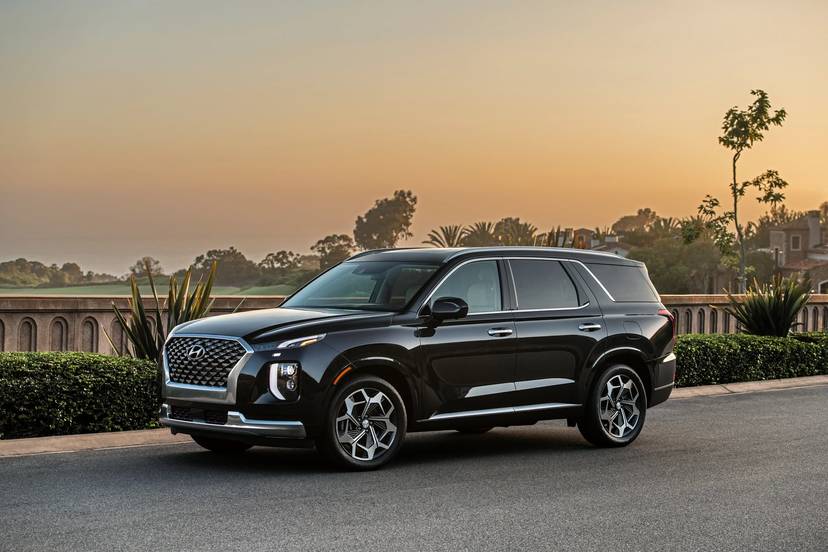
The second-generation Hyundai Veloster retains the kind of quirky design cues that helped set its predecessor apart, things like three conventional doors — one on the driver’s side and two on the passenger side — and a raked roofline. With this redesign, however, Hyundai has brought that offbeat sense of style into the cabin.
The 2019 Veloster starts at $19,385, including an $885 destination charge. We tested two versions of the car: a top-of-the-line Ultimate trim level and an R-Spec trim priced at $29,160 and $23,785, respectively. Both trims had the optional 201-horsepower, turbocharged 1.6-liter four-cylinder engine instead of the standard 147-hp, 2.0-liter four-cylinder. The Ultimate had an optional seven-speed dual-clutch transmission, while the R-Spec had a six-speed manual with a B&M Racing shifter.
Is It Fun to Drive?
The modern-day Mini Cooper has been a standard-bearer for driving fun, and the 2019 Veloster imitates many of its characteristics — if not to such an extreme. Like the turbocharged engine of the Cooper S, the Veloster’s turbo four-cylinder is strong enough to give it some zip in the city as well as passing power on the highway. Ride quality is another similarity with the Mini: The Veloster’s firm suspension keeps body motions in check, but it doesn’t result in a harsh ride. (Compared with base-engine Velosters, turbo-engine versions get thicker front and rear stabilizer bars.) The Veloster’s steering, meanwhile, isn’t as heavy as the Mini’s, but it does feel natural with appropriate weighting and is one of the most dramatic improvements over the previous Veloster.
I was worried the dual-clutch transmission might be a little balky, as they can be, but instead I was impressed with its overall refinement; it has the smoothness of a conventional automatic and makes quick upshifts. It hesitated on kickdown one time on the highway, and it would have been better if its manual-mode gear changes were a little quicker in the car’s Normal setting, but the transmission worked well overall.
The Veloster has three driving modes — Normal, Sport and Smart — and the differences between Normal and Sport are marked. Selecting Sport makes the gas pedal more responsive, eliminating much of the lag present in Normal. It also gives the steering wheel greater heft (though it doesn’t improve steering feedback), lets the engine rev higher before upshifts occur and makes manual-mode shifts quicker. The Sport mode’s main drawback is that the driving experience is jerkier in everyday driving.
The R-Spec’s six-speed manual is the best Hyundai stick shift I’ve driven, and it isn’t far behind the exceptional stick shifts in the Fiat 124 Spider and Honda Civic Type R. The B&M stick is canted forward slightly; as a result, I ended up in 4th gear a few times thinking I was in Neutral, but the shifter’s throws are short and have a satisfying mechanical feel. The clutch pedal isn’t too heavy or springy. It’s forgiving, too.
Is the Cabin Comfortable and Refined?
Even with the standard height-adjustable driver’s seat raised, the Veloster still has a low driving position. You feel the car’s low roofline, too, but there’s enough legroom for taller drivers to settle in.
The Ultimate’s leather-trimmed bucket seats are comfortable, with side bolsters that aren’t overly restrictive. I also like the R-Spec’s unique cloth-covered seats; they have gray fabric inserts that look like sweatpants (but aren’t as soft) and distinctive yellow-and-black-check accents. Views over the hood and over your shoulder are good, but rear visibility is severely limited.
You feel the low roofline even more when you’re in the two-person backseat, where the black headliner and small side windows contribute to the claustrophobia. It’s unfortunate because backseat comfort for adults is otherwise acceptable, with decent legroom and seat comfort.
Though the Veloster has its share of budget-oriented interior trim like hard plastic on the dashboard and doors, the design and available colors keep the interior from looking cheap. The one aspect of the cabin that looks a little low-grade is the shiny plastic on the upper portion of the doors, but all the other hard plastic trim has an upscale, low-gloss finish.
The exterior’s asymmetric styling is reflected in the cabin — especially in the Ultimate trim, which gets a contrasting-color theme: The driver’s side is finished in dark-gray trim while the passenger side has light-gray plastic.
Both Velosters we tested had the optional 8-inch touchscreen multimedia system (a 7-inch touchscreen is standard). Hyundai’s touchscreen interface is very easy to use, with intuitive menus and quick screen response; it’s right up there with Fiat Chrysler Automobiles’ Uconnect system. Built-in navigation is optional for the 8-inch screen, but all Velosters have standard Apple CarPlay and Android Auto connectivity to easily bring your smartphone’s navigation capability to the dashboard screen.
Is It Versatile?
In Hyundai’s quest to give the Veloster a unique, sporty look, it sacrificed a lot of the utility hatchbacks normally offer. The low roofline and small liftgate result in a small opening to the 19.9-cubic-foot cargo area, and you must first clear a high rear lip when loading luggage. The standard 60/40-split backseat folds flat, but there’s a small ledge between the cargo floor and folded seat.
Value in Its Class
The Veloster is a fun-to-drive small car that doesn’t look like everything else on the block, and it also has a lot of technology features — even in its base form. But if you’re looking for traditional hatchback utility, look elsewhere; the Veloster lives like a coupe.
Cars.com’s Editorial department is your source for automotive news and reviews. In line with Cars.com’s long-standing ethics policy, editors and reviewers don’t accept gifts or free trips from automakers. The Editorial department is independent of Cars.com’s advertising, sales and sponsored content departments.















































